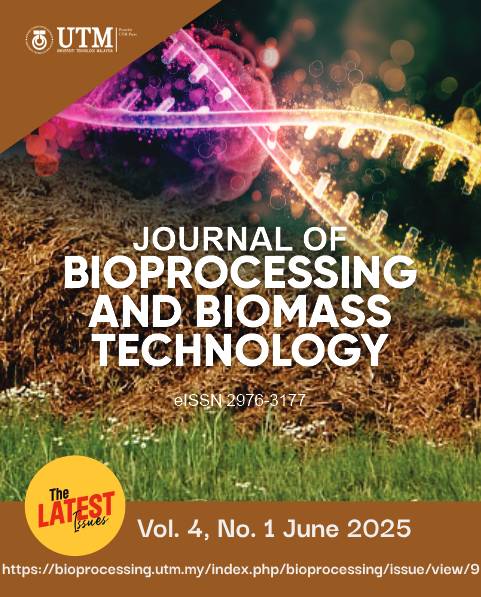Optimization of Temperature, Cellulase Concentration and pH value of Enzymatic Saccharification for Producing Sugar from Ozone Pre-treated Oil Palm Empty Fruit Bunch
DOI:
https://doi.org/10.11113/bioprocessing.v4n1.73Keywords:
OPTIMIZATION, ENZYMATIC SACCHARIFICATION, OIL PALM EMPTY FRUIT BUNCH, RESPONSE SURFACE METHODOLOGYAbstract
Enzymatic saccharification is a crucial step in biomass conversion, where cellulase enzymes break down cellulose into fermentable sugars. This study focuses on optimizing the enzymatic saccharification process for total reducing sugar (TRS) production from ozone pre-treated oil palm empty fruit bunches (OPEFB). A Face-Centred Central Composite Design (FCCD) was employed to evaluate the effects of three key process parameters: temperature (30 °C to 60 °C), cellulase concentration (0.5 mg/mL to 1.5 mg/mL), and pH (3 to 7). A total of 20 experimental runs were conducted. The response variable measured was the concentration of total reducing sugar (TRS) produced. The highest TRS yield achieved was 3.598 mg/mL under the optimized conditions of 39.157 °C, 1.177 mg/mL cellulase concentration, and pH 6.824. These findings demonstrate that ozone pre-treatment significantly enhances the enzymatic hydrolysis efficiency of OPEFB. The optimized conditions suggest a promising pathway for the efficient production of TRS, supporting future upscaling and potential commercialization of bio-based products.
References
Ab Rasid, N. S., Shamjuddin, A., Rahman, A. Z. A., & Amin, N. A. S. (2021). Recent advances in green pre-treatment methods of lignocellulosic biomass for enhanced biofuel production. Journal of Cleaner Production, 321, 129038.
Brown, J., Lindstrom, J. K., Ghosh, A., Rollag, S. A., & Brown, R. C. (2024). Production of sugars from lignocellulosic biomass via biochemical and thermochemical routes. Frontiers in Energy Research, 12, 1347373.
Chen, Z., Chen, L., Khoo, K. S., Gupta, V. K., Sharma, M., Show, P. L., & Yap, P. S. (2023). Exploitation of lignocellulosic-based biomass biorefinery: A critical review of renewable bioresource, sustainability and economic views. Biotechnology Advances, 69, 108265.
Gonzales, R. R., Kim, J. S., & Kim, S. H. (2019). Optimization of dilute acid and enzymatic hydrolysis for dark fermentative hydrogen production from the empty fruit bunch of oil palm. International Journal of Hydrogen Energy, 44(4), 2191-2202.
Guo, H., Chang, Y., & Lee, D. J. (2018). Enzymatic saccharification of lignocellulosic biorefinery: research focuses. Bioresource technology, 252, 198-215.
Lee, K. M., Zanil, M. F., Chan, K. K., Chin, Z. P., Liu, Y. C., & Lim, S. (2020). Synergistic ultrasound-assisted organosolv pretreatment of oil palm empty fruit bunches for enhanced enzymatic saccharification: an optimization study using artificial neural networks. Biomass and Bioenergy, 139, 105621.
Ling, T. P., Hassan, O., Badri, K., Maskat, M. Y., & Mustapha, W. A. W. (2013). Sugar recovery of enzymatic hydrolysed oil palm empty fruit bunch fiber by chemical pretreatment. Cellulose, 20(6), 3191-3203.
Maryana, R., Bardant, T. B., Ihsan, D. M., Das, A. K., Irawan, Y., Rizal, W. A., ... & Sudiyani, Y. (2024). Reducing sugars and bioethanol production from oil palm empty fruit bunch by applying a batch and continuous pretreatment process with low temperature and pressure. Biomass Conversion and Biorefinery, 14(10), 11155-11164.
Postiaux, A., Putra, F. J. N., Kahar, P., Richel, A., & Ogino, C. (2024). Maleic acid-butanol pretreatment to enhance cellulose accessibility for enzymatic hydrolysis and ethanol production from oil palm empty fruit bunch. ACS Environmental Au, 5(1), 76-85.
Rizal, N. F. A. A., Ibrahim, M. F., Zakaria, M. R., Abd-Aziz, S., Yee, P. L., & Hassan, M. A. (2018). Pre-treatment of oil palm biomass for fermentable sugars production. Molecules, 23(6), 1381.
Uchegbu, N. N., Ude, C. N., Okoyeuzu, C. F., Nwadi, O. M. M., Rasaq, W. A., Ogbonna, C. U., ... & Okpala, C. (2022). Optimisation of enzymatic fermented glucose production of wild cocoyam starch using response surface methodology. Glob. NEST J, 24, 351-361.
















